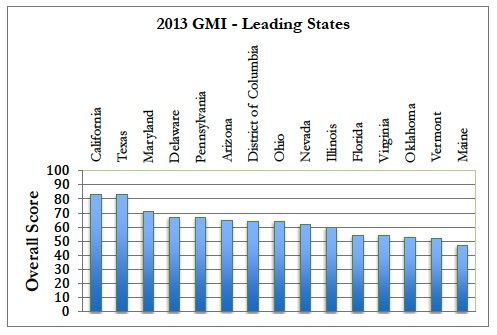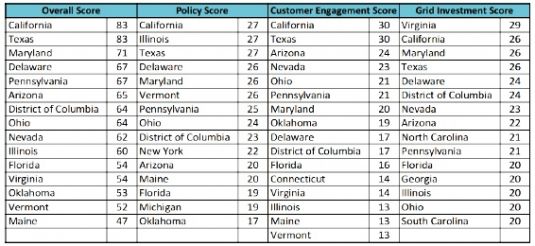Which states are leading the nation in smart grid investment -- and which policies and customer engagement practices are driving that lead?
A new report from the GridWise Alliance and the Smart Grid Policy Center lays out the answers to these questions, in a first-ever state-by-state ranking across those three categories.
The Grid Modernization Index Report (PDF), released Sunday at the National Association of Regulatory Utility Commissioners (NARUC) meeting in Washington, D.C., lays out a treasure trove of statistical detail for industry players and state utility regulators, along with some unexpected findings on which state policies do -- and don’t -- correlate to more effective smart grid efforts.

“It’s not just measuring that the technology has been deployed,” Becky Harrison, CEO of the GridWise Alliance, said in a Friday prebriefing. “It’s measuring how the utilities are gaining value from that and introducing ways for the customers to engage.”
That means that the overall state rankings have been further broken up into which states are leading in each of those three categories. That chart reveals some interesting discrepancies.
While Texas and California were the top-ranked states, they got there by different routes, Harrison noted. For example, while both states are leading the nation in terms of smart meter deployments, Texas’ deregulated and competitive energy markets have allowed retail power providers to use those assets to increase customer pricing programs and engagement efforts, whereas in California’s regulated utility environment, that hasn’t happened as quickly.
Texas' approach to smart meter data management and integration have also “enabled the back-end data centers that have allowed these systems to work in that deregulated environment,” she said.
On the other hand, in California, which has the nation’s most aggressive policies on renewable energy, “We’re seeing investments on the grid side help them recognize and deal with the higher distribution of generation resources that are out there,” she said. (California is also taking the lead in pushing energy storage into the grid.)
The study also revealed some correlations between smart grid acumen and other energy policies. For example, states that had received a large portion of smart grid stimulus grants from the American Reinvestment and Recovery Act showed a higher score across all three smart grid categories. Another link was found between the 26 states that have renewable portfolio standards requiring solar, wind and other green energy resources, showing a strong correlation to high scores in smart grid investment, policy and customer engagement -- although the study didn’t delve into just what linkages drove that correlation.
On the other hand, some correlations that were expected to appear didn’t actually show up, Harrison noted. For example, “We suspected there might be some correlation with electricity pricing,” but the study found no statistical link between the price of power and the smart grid scores amongst states, she said.




